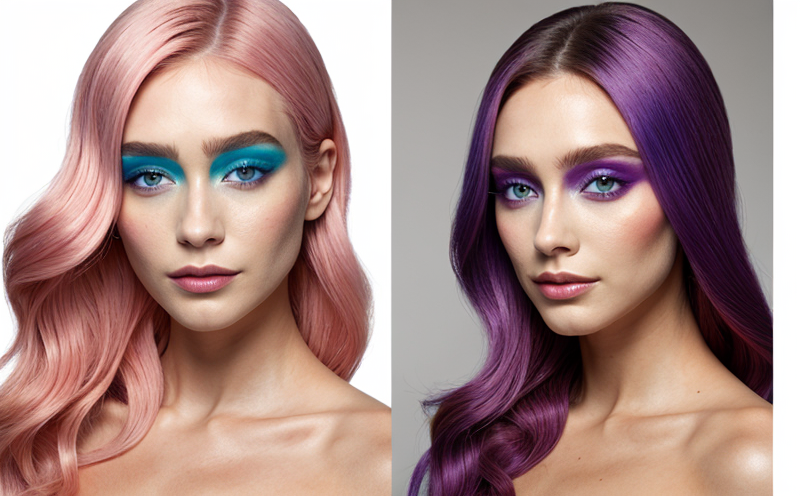Color Cosmetics Testing
The testing of color cosmetics is a critical process that ensures product safety, efficacy, and compliance with international standards. Color cosmetics encompass a wide range of products including lipstick, eyeshadow, blush, nail polishes, and other pigmented formulas designed to enhance the appearance of the skin or hair. The primary goal of this testing is to guarantee that these products are safe for use, free from harmful contaminants, and meet stringent quality standards.
Quality control in color cosmetics involves several key areas: pigment stability, texture evaluation, color uniformity, and packaging integrity. Pigment stability tests assess the longevity of pigments under various conditions such as temperature, humidity, and light exposure to ensure that colors do not fade or change over time. Texture evaluations focus on the feel and spreadability of a product, which are crucial for user satisfaction.
Color uniformity is tested by examining how consistently the color appears across different packaging sizes or batches. This ensures that consumers receive products with consistent appearance every time they purchase. Packaging integrity tests verify that the container holds the pigment in its intended form and does not allow leakage, which could compromise product quality.
The testing process typically begins with a thorough examination of raw materials to ensure that all ingredients are safe for use. This includes checking for potential allergens, irritants, and other harmful substances. Once formulated, samples undergo rigorous analysis using advanced laboratory techniques such as spectrophotometry for color measurement and particle size distribution analysis for pigment evaluation.
Regulatory compliance is a key aspect of color cosmetics testing. Laboratories adhere to international standards like ISO 21795:2020 and ASTM D4083-15, which provide guidelines on how to conduct these tests accurately. Compliance officers rely on these standards to ensure that products meet legal requirements in different markets.
Another important consideration is the impact of color cosmetics on the environment. Many consumers prefer eco-friendly options, and testing laboratories play a role in ensuring that these products are not only safe but also sustainable. This includes evaluating packaging materials for recyclability and assessing the use of biodegradable ingredients.
Quality and Reliability Assurance
The quality assurance process for color cosmetics is designed to ensure that every batch produced meets the highest standards. This involves multiple stages, from raw material inspection to final product release. Raw materials must be sourced from reputable suppliers who provide certificates of analysis (COAs) detailing their purity and composition.
During formulation development, R&D engineers work closely with compliance officers to ensure that new products meet all necessary regulatory requirements. This includes conducting stability studies over extended periods to confirm that the product maintains its quality through shelf life. Stability testing is essential because it helps identify any potential issues early in the production cycle.
Once formulated, samples are tested using various analytical methods tailored to each type of cosmetic. For instance, lipstick may require different tests than nail polish due to differences in formulation and application method. These tests can include pH measurement, viscosity determination, and microbial contamination checks.
Packaging is also subjected to strict scrutiny. It must protect the product from external factors while maintaining its aesthetic appeal. Testing for packaging integrity involves simulating real-world conditions such as exposure to sunlight or changes in temperature and humidity levels. This helps ensure that the container remains intact throughout shipping and storage.
Compliance officers play a vital role by keeping up-to-date with all relevant regulations and ensuring that each step of the production process complies with these rules. They collaborate closely with R&D teams to incorporate any necessary changes into ongoing projects. By doing so, they help maintain high standards across the entire supply chain.
Environmental and Sustainability Contributions
- Eco-friendly ingredients: Many modern color cosmetics are formulated using plant-based or other renewable resources that have less environmental impact than traditional petroleum-derived alternatives.
- Packaging improvements: Laboratories often explore ways to make packaging more sustainable, such as using recycled materials or designing containers that require less energy during manufacturing processes.
- Reduced waste streams: By optimizing formulations and production methods, laboratories can minimize the amount of waste generated during color cosmetics production.
Competitive Advantage and Market Impact
In today’s competitive market, achieving superior quality through stringent testing is essential for maintaining a strong brand presence. Consumers increasingly demand transparency about the safety and environmental impact of products they purchase. Companies that invest in comprehensive color cosmetics testing not only meet these expectations but also set themselves apart from competitors.
By adhering to strict quality assurance protocols, companies can build trust with their customers, leading to increased loyalty and repeat business. Additionally, successful compliance with international standards opens doors to broader market access, particularly in regions with stringent regulatory environments.
The use of advanced laboratory techniques also enables continuous innovation within the industry. Companies that stay at the forefront of technological advancements are better positioned to introduce new products faster than their rivals. This rapid iteration cycle allows brands to respond quickly to changing trends and consumer preferences.





